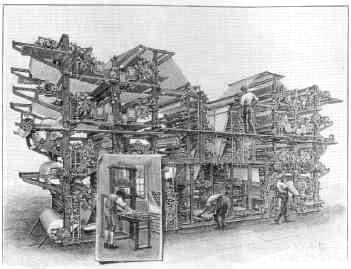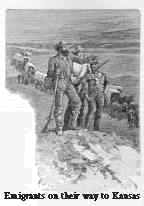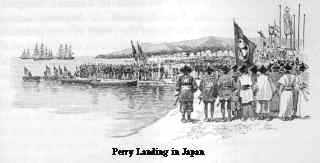NEGenWeb Project
Resource Center OLLibrary
|
262
|
LEADING FACTS OF AMERICAN HISTORY
|
[1852
|
cruel side. People who took up the book could not lay it down
until they had finished it. They laughed and cried, and laughed
again, over "Topsy," "Eva," and "Uncle Tom"; but they ended with
tears in their eyes. No arguments, no denials, could shake the
influence of the story. In a single year two hundred thousand
copies were sold in this country, and in a short time the total
sales here had reached half a million copies.
From this time onward a silent revolution was
going on. The forces for slavery and those against it were girding
themselves up for the terrible struggle. The great leaders of the
nation on both sides -- Clay, Webster, Calhoun -- had recently
died. New men were taking their places in Congress, -- Charles
Sumner representing the North, Jefferson Davis, the South. In the
battles which these two men fought in words we have the beginning
of that contest which was soon to end in civil war. Both felt that
the time was very soon coming when the republic must stand wholly
free or wholly on the side of slavery.
302. Summary. The four chief events of
the Taylor and Fillmore administrations were: (I) the debate on
the extension of slavery in the new territory gained by the
Mexican War; (2) the Compromise Measures of 1850, including the
Fugitive-Slave Law; (3) the publication of "Uncle Tom's Cabin";
and (4) the beginning of the great final struggle in Congress
between the North and the South.
FRANKLIN
PIERCE
(DEMOCRAT)
303. Pierce's
Administration (Fourteenth President, One Term, 1853-1857); the
"World's Fair" at New York City; American Labor-Saving
Machines. The inauguration of President Pierce1
occurred at a time when a majority of the people were tired of
hearing about slavery. It was a period of great business
prosperity;
1 Franklin Pierce was
born in New Hampshire in 1804; died, 1869. He was in Congress from
1837-1842, and was a brigadier general in the Mexican War. He was
elected President (William R. King of Alabama, Vice President) by
the Democrats, over General Scott, the Whig candidate. The Whig
party had practically ceased to exist before the next presidential
election, in 1856. The Free Soilers humorously declared that it
died "of an attempt to swallow the Fugitive-Slave Law" (which the
Whig National Convention had accepted in 1832). In 1852 a new
political party called the American Party, or "Know Nothings,"
came
|
1853]
|
AMERICAN LABOR-SAVING MACHINES
|
263
|
almost everybody seemed to be making money, and some newspapers
called it the "golden age." In the summer (1853) the first
American "World's Fair" was opened in New York City in the
"Crystal Palace."
The exhibition proved that no country in the
world could equal our own in labor-saving machines. Four of the
most remarkable

A
TWENTIETH-CENTURY
ELECTRIC NEWSPAPER
PRINTING PRESS
(With cut of Franklin's press for comparison)
of these were the newly invented sewing machines which were
then beginning to come into general use; next, the horse reapers
and mowers, and finally an improved steam printing press, which
could send out a continuous stream of four-page newspapers at tile
rate of over 200 a minute. That was thought extraordinary
speed
into existence. They had a secret organization,
and their object was to exclude all but native American citizens
from office, to check the power of Catholicism, and to oppose the
admission of foreigners to citizenship except after very long
residence here. Their motto was, "Americans must rule America."
The "Know Nothings became a national party, exerted considerable
influence for a few years, and then died out.
|
264
|
LEADING FACTS OF AMERICAN HISTORY
|
[1853
|
|
then, but now we have presses, driven by electricity,
which can print 1600 sixteen-page sheets a minute, or
nearly 100,000 an hour. This makes a roll of paper
seventy miles long.
The horse reapers and mowers for
cutting grain and grass (1845) showed the immense advance
we had made over the slow work formerly done by hand with
sickle and scythe. The French  Academy
of Sciences declared that the American inventor of the
horse reaper had "done more for the cause of agriculture
than any man living." The effect on the settlement of the
West was wonderful, for by using these machines the
farmer could do as much work in a few hours as he had
been able to do before in a whole week.1 But
these machines have since been superseded, on some of the
immense farms at the West, by "harvesters," which cut the
grain, thrash it, clean it, and put it up in bags in the
field. These "harvesters" sometimes require more than
thirty horses to draw them or they are propelled by steam
(§ 371). Academy
of Sciences declared that the American inventor of the
horse reaper had "done more for the cause of agriculture
than any man living." The effect on the settlement of the
West was wonderful, for by using these machines the
farmer could do as much work in a few hours as he had
been able to do before in a whole week.1 But
these machines have since been superseded, on some of the
immense farms at the West, by "harvesters," which cut the
grain, thrash it, clean it, and put it up in bags in the
field. These "harvesters" sometimes require more than
thirty horses to draw them or they are propelled by steam
(§ 371).
304. Commodore M. C. Perry opens the
Ports of Japan. Not long after the close of the
Crystal Palace Exhibition, Commodore M. C. Perry, brother
of the late Commodore O. H. Perry of Lake Erie fame
(§ 229), sailed into one of the ports of Japan with
the first fleet of steamers that had ever entered a
harbor of that island. For over two centuries that
country had been almost practically closed to the entire
world. Through Perry's influence the government of Japan
made a treaty with the United States admitting our ships
to trade. We made the Emperor presents of a
locomotive
1 Obed
Hussey patented his horse reaper in 1834 and Cyrus Hall
McCormick patented his machine a few months later.
Eventually these remarkable farming implements were
improved so that they not only cut the grain in the
field, but bound it up in sheaves. Speaking of one of
these machines, William H. Seward, then in the United
States Senate, said, in 1859, that it had pushed the line
of civilization [in the United States] westward
thirty miles each year. And Professor Alexander Johnston
says that the results of the horse reaper "have been
hardly less than that of the locomotive in their
importance to the United States. . . . It was
agricultural machinery that made Western farms
profitable, and enabled the railways to fill the West so
rapidly." See also Coman's "Industrial History of the
United States," p. 244.
|
|
1853-1854]
|
THE KANSAS--NEBRASKA ACT, 1854
|
265
|
with a train of cars, and a line of telegraph, -- the first
ever seen in that country, which has since adopted, through our
influence, both steam and electricity. Later (1901), the Japanese
erected a monument commemorating Commodore Perry's work. It stands
in Perry Park, Kurihama, Japan, at which port the American officer
first landed.
305. The Kansas-Nebraska Act, 1854; Rise of
the Modern Republican Party, 1856. It will be remembered that
the Missouri Compromise of 1820 shut out slavery from the
territory west and north of Missouri (§ 243). At the time the
Compromise was made it was solemnly declared that it would stand
"forever." But the end of that "forever" was now reached. In 1853
a
movement began in Missouri to carry slavery into the
Nebraska country west of it. In 1854 Senator Stephen A. Douglas of
Illinois -- the "Little Giant," as his friends called him1
-- proposed a law entitled the Kansas-Nebraska Bill. That
bill cut the Nebraska country into two parts, of which the
southern portion was called Kansas; and it left the settlers of
these two territories to decide whether they would have slave
labor or not.2 Congress
1 Senator Douglas
was short in stature and stoutly built. His great intellectual
ability and marked decision of character got for him the name of
the "Little Giant." He died in 1861, shortly after the outbreak of
the Civil War. His dying message to his sons was his entreaty that
they should stand by the Union and the Constitution.
2 Senator Douglas claimed that in
giving the people of Kansas and Nebraska the power of choosing
whether they would have slave labor or not, he was simply
extending that part of Clay's Compromise measure of 1850 (§
299) which gave the same privilege to the people of the
territories of New Mexico and Utah, (See Map, p. 270).
|
266
|
LEADING FACTS OF AMERICAN HISTORY
|
[1854-1856
|
passed the bill, and thus repealed or set aside the Missouri
Compromise or agreement made in 1820 (§ 243). The North was
indignant at the new law. Senator Douglas was hooted in the
streets. Mass meetings were held to denounce him, and so many
images of him were made and burned that Mr. Douglas himself said
that he traveled from Washington to Chicago by the light of his
own blazing effigies.
One of the most important results of the
controversy over the Kansas-Nebraska Bill was that it led to the
formation in 1856 of a new political party. Those who opposed the
repeal of the Missouri Compromise and the extension of slavery in
the West now united and took the name of Republicans (§
203).
306. The Struggle for the Possession of
Kansas; Emigrants from Missouri and from New England. A
desperate struggle (1854) began between the North and the South
for the possession of Kansas.1 Bands of slaveholders
armed with rifles crossed the Missouri River and seized lands in
the new territory. They settled a town which they named Atchison
in honor of Senator Atchison of Missouri.
Next, the New England Aid Society of Boston sent
out a body of armed emigrants, singing,
"We cross the prairies, as of
old
The Pilgrims crossed the sea,
To make the West, as they the East,
The Homestead of the free."2
They settled about forty miles to the
southwest of Atchison. They called their little cluster of tents
and log cabins Lawrence, because Amos A. Lawrence was treasurer of
the society, which was established to aid Northern men to build
homes in Kansas, and to make the territory a free state.
307. The Rival Governments of Kansas; Civil
War in the Territory. The rival bands of settlers soon set up
governments to suit themselves. The "Free-state men" made their
headquarters
1 In speaking of
this coming struggle, Honorable William H. Seward of New York
said, in the United States Senate, 1854: "Come on, then, gentlemen
of the slave states; since there is no escaping your challenge, I
accept it on behalf of Freedom. We will engage in competition for
the virgin soil of Kansas, and God give the victory to the side
that is stronger in numbers as it is in right."
2 See Whittier's "The Song of the
Kansas Emigrant."
|
1856-]
|
CIVIL. WAR IN KANSAS
|
267
|
|
at Topeka and Lawrence; the "Slave-state men" made
theirs at Leavenworth and Lecompton.
During the next five years (1854-1859)
the territory was torn by civil war, and fairly earned
the title of "Bleeding Kansas." The "Free-state men"
denounced the opposite party as "Border Ruffians"; the
"Slave-state men called the Free-state men"
"Abolitionists" and "Black Republicans."
308. Attack on Lawrence; John Brown;
Assault on Charles Sumner. In the course of this
period of violence and bloodshed the "Slave-state men"
attacked Lawrence, plundered the  town,
and burned some of its chief buildings. This roused the
spirit of vengeance in the heart of "Old John Brown" of
Osawatomie.1 He was a descendant of one of the
Pilgrims who came over in the Mayflower (§ 73), and
he had made a solemn vow to "kill American slavery." In
return for the attack on Lawrence, Brown got together a
small band, surprised a little settlement of Slave-state
men on Pottawatomie Creek, dragged five of them from
their beds, and deliberately murdered them. Later, Brown
crossed into Missouri, destroyed considerable property,
freed eleven slaves, and shot one of the slave owners. In
the end, the "Free-state men" won the victory, and
Kansas, following the example of town,
and burned some of its chief buildings. This roused the
spirit of vengeance in the heart of "Old John Brown" of
Osawatomie.1 He was a descendant of one of the
Pilgrims who came over in the Mayflower (§ 73), and
he had made a solemn vow to "kill American slavery." In
return for the attack on Lawrence, Brown got together a
small band, surprised a little settlement of Slave-state
men on Pottawatomie Creek, dragged five of them from
their beds, and deliberately murdered them. Later, Brown
crossed into Missouri, destroyed considerable property,
freed eleven slaves, and shot one of the slave owners. In
the end, the "Free-state men" won the victory, and
Kansas, following the example of
I John
Brown, born in Torrington, Connecticut, 1800, was
executed at Charlestown, Virginia (now West Virginia),
December 2, 1859, for having attempted by armed force to
liberate slaves in that state. He was a descendant of
Peter Brown, who came over in the Mayflower in 1620. When
a boy he chanced to see a slave boy cruelly beaten by his
master, and he then and there vowed (so he says) "eternal
war with slavery." In 1848 he purchased a farm in North
Elba, New York, but spent a great deal of his time in
aiding runaway slaves to get to Canada. He went out to
Osawatomie, Kansas, in 1855, to take part in making that
territory a free state, and also, as he says, to strike a
blow at slavery. Brown's party declared that they
perpetrated the "Pottawatomie Massacre" in return for the
assassination of five "Free-state men" by the opposite
party.
|

 Academy
of Sciences declared that the American inventor of the
horse reaper had "done more for the cause of agriculture
than any man living." The effect on the settlement of the
West was wonderful, for by using these machines the
farmer could do as much work in a few hours as he had
been able to do before in a whole week.1 But
these machines have since been superseded, on some of the
immense farms at the West, by "harvesters," which cut the
grain, thrash it, clean it, and put it up in bags in the
field. These "harvesters" sometimes require more than
thirty horses to draw them or they are propelled by steam
(§ 371).
Academy
of Sciences declared that the American inventor of the
horse reaper had "done more for the cause of agriculture
than any man living." The effect on the settlement of the
West was wonderful, for by using these machines the
farmer could do as much work in a few hours as he had
been able to do before in a whole week.1 But
these machines have since been superseded, on some of the
immense farms at the West, by "harvesters," which cut the
grain, thrash it, clean it, and put it up in bags in the
field. These "harvesters" sometimes require more than
thirty horses to draw them or they are propelled by steam
(§ 371).
 town,
and burned some of its chief buildings. This roused the
spirit of vengeance in the heart of "Old John Brown" of
Osawatomie.1 He was a descendant of one of the
Pilgrims who came over in the Mayflower (§ 73), and
he had made a solemn vow to "kill American slavery." In
return for the attack on Lawrence, Brown got together a
small band, surprised a little settlement of Slave-state
men on Pottawatomie Creek, dragged five of them from
their beds, and deliberately murdered them. Later, Brown
crossed into Missouri, destroyed considerable property,
freed eleven slaves, and shot one of the slave owners. In
the end, the "Free-state men" won the victory, and
Kansas, following the example of
town,
and burned some of its chief buildings. This roused the
spirit of vengeance in the heart of "Old John Brown" of
Osawatomie.1 He was a descendant of one of the
Pilgrims who came over in the Mayflower (§ 73), and
he had made a solemn vow to "kill American slavery." In
return for the attack on Lawrence, Brown got together a
small band, surprised a little settlement of Slave-state
men on Pottawatomie Creek, dragged five of them from
their beds, and deliberately murdered them. Later, Brown
crossed into Missouri, destroyed considerable property,
freed eleven slaves, and shot one of the slave owners. In
the end, the "Free-state men" won the victory, and
Kansas, following the example of


